 W
WMarshal of the Royal Air Force (MRAF) is the highest rank in the British Royal Air Force (RAF). In peacetime it was granted to RAF officers in the appointment of Chief of the Defence Staff (CDS), and to retired Chiefs of the Air Staff (CAS), who were promoted to it on their last day of service. While surviving marshals of the RAF retain the rank for life, the highest rank to which officers on active service are promoted is now air chief marshal. Although general promotions to Marshal of the Royal Air Force have been discontinued since the British defence cuts of the 1990s, further promotions to the rank may still be made in wartime, for members of the Royal Family and certain very senior RAF air officers in peacetime at the discretion of the monarch; all such promotions in peacetime are only honorary, however. In 2012, Charles, Prince of Wales was promoted to the rank while in 2014 Lord Stirrup, who had served as Chief of the Air Staff and Chief of the Defence Staff for over seven years, was also promoted.
 W
WMarshal of the Royal Air Force Sir Michael James Beetham, was a Second World War bomber pilot and a high-ranking commander in the Royal Air Force from the 1960s to the 1980s. As Chief of the Air Staff during the Falklands War he was involved in the decision to send the Task Force to the South Atlantic. At the time of his death Beetham was one of only six people holding his service's most senior rank and, excluding Prince Philip's honorary rank, and had the longest time in rank, making him the senior Marshal of the Royal Air Force.
 W
WMarshal of the Royal Air Force Sir Dermot Alexander Boyle, was a senior officer in the Royal Air Force. He served in the Second World War initially as a staff officer with the Advanced Air Striking Force in Reims in which capacity he organised the evacuation of the Force through Brest in May 1940. His war service included tours as a bomber squadron commander, as a station commander and also as an air group commander. He was Chief of the Air Staff in the late 1950s and, in that role, deployed British air power during the Suez Crisis in October 1956 and defended the RAF against the views of Duncan Sandys, the Minister for Defence, who believed that the V bomber force rendered manned fighter aircraft redundant.
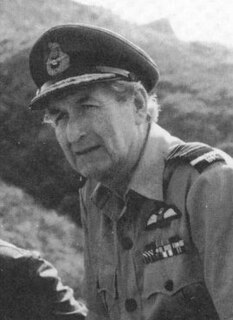 W
WMarshal of the Royal Air Force Neil Cameron, Baron Cameron of Balhousie, was a senior officer in the Royal Air Force. He fought in the Second World War as a fighter pilot taking part in the Battle of Britain, the Battle of Alam el Halfa, the First Battle of El Alamein and the Second Battle of El Alamein and then in operations in Burma. He served as Chief of the Air Staff in the late 1970s advising the British Government on the reinforcement of the British garrison in Belize which was under threat from Guatemala at the time. He also served as the Chief of the Defence Staff at the end of the 1970s in which role he secured pay comparability for services personnel involved in civil support during the firemen's strike, visited the People's Republic of China and lectured extensively on the Soviet air threat.
 W
WCharles, Prince of Wales is the heir apparent to the British throne as the eldest child of Queen Elizabeth II. He has been Duke of Cornwall and Duke of Rothesay since 1952, and he is the oldest and longest-serving heir apparent in British history. He is also the longest-serving Prince of Wales, having held that title since 1958.
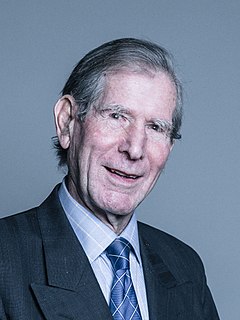 W
WMarshal of the Royal Air Force David Brownrigg Craig, Baron Craig of Radley, is a retired Royal Air Force officer and member of the House of Lords. He was a fast jet pilot in the 1950s, a squadron commander in the 1960s and a station commander in the 1970s. He served as Chief of the Air Staff during the late 1980s, when the Boeing Airborne early warning and control system was ordered and the European Fighter programme was being developed. He then served as Chief of the Defence Staff during the Gulf War. He was granted a life peerage as Baron Craig of Radley after his retirement from active service in 1991, sitting as a crossbencher.
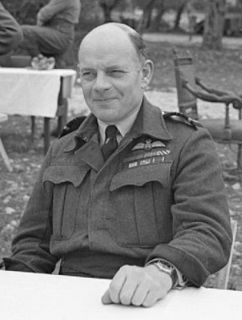 W
WMarshal of the Royal Air Force Sir William Forster Dickson, was a Royal Naval Air Service aviator during the First World War, a senior officer in the Royal Air Force during the inter-war years and a Royal Air Force commander during and after the Second World War. Dickson was Chief of the Air Staff in the mid-1950s, in which role his main preoccupation was the establishment of the V Force and the necessary supporting weapons, airfields and personnel. He also served as the first Chief of the Defence Staff in the late 1950s.
 W
WMarshal of the Royal Air Force William Sholto Douglas, 1st Baron Douglas of Kirtleside, was a senior commander in the Royal Air Force. After serving as a pilot, then a flight commander and finally as a squadron commander during the First World War, he served as a flying instructor during the inter-war years before becoming Director of Staff Duties and then Assistant Chief of the Air Staff at the Air Ministry.
 W
WEdward VIII, was King of the United Kingdom and the Dominions of the British Empire, and Emperor of India, from 20 January 1936 until his abdication on 11 December of that year.
 W
WMarshal of the Royal Air Force Sir Edward Leonard Ellington, was a senior officer in the Royal Air Force. He served in the First World War as a staff officer and then as Director-General of Military Aeronautics and subsequently as Controller-General of Equipment. In the inter-war years he held command positions in the Middle East, in India and then in Iraq. He served as Chief of the Air Staff in the mid-1930s and in that role he implemented a plan, known as 'Scheme F'. This scheme implemented an increase in the size of the Royal Air Force to 187 squadrons within three years to counter the threat from Hitler's Germany. He also broke up the command known as "Air Defence of Great Britain" to create RAF Fighter Command, RAF Bomber Command, RAF Coastal Command and RAF Training Command. He then served as Inspector-General of the RAF until his retirement in 1940.
 W
WMarshal of the Royal Air Force Samuel Charles Elworthy, Baron Elworthy, was a senior officer in the Royal Air Force. He served as commander of a squadron of Blenheim bombers and then as a station commander during the Second World War. He became Chief of the Air Staff in the mid-1960s and implemented the cancellation of the TSR-2 strike aircraft and the HS681 military transport aircraft programmes. He also became Chief of the Defence Staff in which role he oversaw the evacuation from Aden in November 1967 and had to respond to the growing crisis in Northern Ireland in the late 1960s.
 W
WGeorge V was King of the United Kingdom and the British Dominions, and Emperor of India, from 6 May 1910 until his death in 1936.
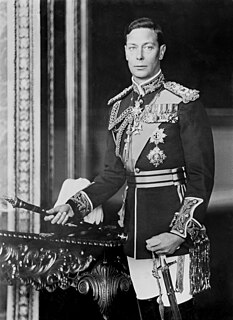 W
WGeorge VI was King of the United Kingdom and the Dominions of the British Commonwealth from 11 December 1936 until his death in 1952. He was also Emperor of India from 1936 until 1947, when the British Raj was dissolved.
 W
WPrince Henry, Duke of Gloucester, was the third son and fourth child of King George V and Queen Mary. He served as Governor-General of Australia from 1945 to 1947, the only member of the British royal family to hold the post.
 W
WMarshal of the Royal Air Force Sir John Grandy, was a senior officer in the Royal Air Force. He was the only officer who fought and commanded a squadron during the Battle of Britain to reach the post of Chief of the Air Staff. In the latter role he implemented the final stages of the RAF's withdrawal from the Persian Gulf and the Far East, oversaw the ordering and subsequent cancellation of the F-111 strike aircraft and handed over Britain's nuclear deterrent role to the Royal Navy.
 W
WMarshal of the Royal Air Force Sir Peter Robin Harding, is a retired Royal Air Force officer who served as a bomber pilot in the 1950s, a helicopter squadron commander in the 1960s and a station commander in the 1970s. He became Chief of the Air Staff in 1988 and served in that role during the Gulf War in 1991. He became Chief of the Defence Staff in December 1992 but resigned after his affair with Lady (Bienvenida) Buck, the wife of Conservative MP Antony Buck, became public.
 W
WMarshal of the Royal Air Force Sir Arthur Travers Harris, 1st Baronet, commonly known as "Bomber" Harris by the press and often within the RAF as "Butcher" Harris, was Air Officer Commanding-in-Chief (AOC-in-C) RAF Bomber Command during the height of the Anglo-American strategic bombing campaign against Nazi Germany in the Second World War. In 1942, the British Cabinet agreed to the "area bombing" of German cities. Harris was given the task of implementing Churchill's policy and supported the development of tactics and technology to perform the task more effectively. Harris assisted British Chief of the Air Staff Marshal of the Royal Air Force Charles Portal in carrying out the United Kingdom's most devastating attacks against the German infrastructure and population, including the Bombing of Dresden.
 W
WMarshal of the Royal Air Force Sir Andrew Henry Humphrey, was a senior officer in the Royal Air Force. He fought in the Second World War as a fighter pilot taking part in the Battle of Britain and also took part in the withdrawal from Aden in November 1967. He served as the Chief of the Air Staff advising the new Labour Government on the implementation of their latest Defence Review. He then served as Chief of the Defence Staff but caught pneumonia within three months of taking office and died shortly afterwards.
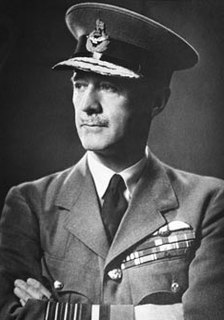 W
WMarshal of the Royal Air Force Cyril Louis Norton Newall, 1st Baron Newall, was a senior officer of the British Army and Royal Air Force. He commanded units of the Royal Flying Corps and Royal Air Force in the First World War, and served as Chief of the Air Staff during the first years of the Second World War. From 1941 to 1946 he was the Governor-General of New Zealand.
 W
WPrince Philip, Duke of Edinburgh, is the husband of Queen Elizabeth II of the United Kingdom and other Commonwealth realms.
 W
WMarshal of the Royal Air Force Sir Thomas Geoffrey Pike, was a senior officer in the Royal Air Force. He served in the Second World War as a night fighter squadron commander and then as a station commander. He was Chief of the Air Staff in the early 1960s and, in that role, deployed British air power as part of the British response to the Brunei Revolt. Also, in the face of escalating costs, he implemented the cancellation of the British Blue Streak ballistic missile system but then found the RAF was without any such capability when the Americans cancelled their own Skybolt ballistic missile system. He went on to be Deputy Supreme Commander Supreme Headquarters Allied Powers Europe in the mid-1960s.
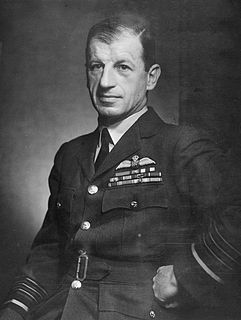 W
WMarshal of the Royal Air Force Charles Frederick Algernon Portal, 1st Viscount Portal of Hungerford, was a senior Royal Air Force officer. He served as a bomber pilot in the First World War, and rose to become first a flight commander and then a squadron commander, flying light bombers on the Western Front.
 W
WMarshal of the Royal Air Force Sir John Maitland Salmond, was a British military officer who rose to high rank in the Royal Flying Corps and then the Royal Air Force. During the First World War he served as a squadron commander, a wing commander and then as General Officer Commanding the RAF on the Western Front towards the end of the war. He went on to be Air Officer Commanding British Forces in Iraq in the early 1920s when he halted a Turkish invasion and sought to put down a Kurdish uprising against King Faisal, the British-sponsored ruler of Iraq. He was Chief of the Air Staff in the early 1930s and bitterly opposed the position taken by British politicians at the World Disarmament Conference in Geneva, which would have led to the UK's complete aerial disarmament. In the event the talks broke down when Adolf Hitler withdrew from the Conference in October 1933.
 W
WMarshal of the Royal Air Force Sir John Cotesworth Slessor,, sometimes known as Jack Slessor, was a senior commander in the Royal Air Force (RAF), serving as Chief of the Air Staff from 1950 to 1952. As a pilot in the Royal Flying Corps during the First World War, he saw action with No. 17 Squadron in the Middle East, earning the Military Cross, and with No. 5 Squadron on the Western Front, where he was awarded the Belgian Croix de Guerre. Between the wars he commanded No. 4 Squadron in England, and No. 3 (Indian) Wing, earning the Distinguished Service Order for operations with the latter in Waziristan. In 1936, he published Air Power and Armies, which examined the use of air power against targets on and behind the battlefield.
 W
WMarshal of the Royal Air Force Sir Denis Frank Spotswood, was a senior commander in the Royal Air Force. He fought in the Second World War as a flying boat pilot and then as a coastal reconnaissance squadron commander during Operation Torch, the invasion of North Africa. He served as a station commander in the late 1940s and early 1950s before becoming a senior air commander in the late 1950s. As the Chief of the Air Staff in the early 1970s he had a major role in implementing the defence savings demanded by the Heath Government in the face of economic difficulties at the time.
 W
WMarshal of the Royal Air Force Graham Eric Stirrup, Baron Stirrup,, informally known as Jock Stirrup, is a former senior Royal Air Force commander who was the Chief of the Defence Staff from 2006 until his retirement in late 2010. He is now a Crossbench member of the House of Lords. In April 2013, he was appointed a Knight of the Order of the Garter by Queen Elizabeth II.
 W
WMarshal of the Royal Air Force Arthur William Tedder, 1st Baron Tedder, was a senior Royal Air Force commander. He was a pilot and squadron commander in the Royal Flying Corps in the First World War and he went on to serve as a senior officer in the Royal Air Force during the inter-war years when he served in Turkey, Great Britain and the Far East.
 W
WMarshal of the Royal Air Force Hugh Montague Trenchard, 1st Viscount Trenchard, was a British officer who was instrumental in establishing the Royal Air Force. He has been described as the "Father of the Royal Air Force."
 W
WMarshal of the Royal Air Force Sir Keith Alec Williamson, was a senior officer in the Royal Air Force. He served with the Royal Australian Air Force flying Meteors in a ground attack role during the Korean War. He was a squadron commander and then a station commander during the 1960s and a senior air commander in the 1980s. He was Chief of the Air Staff during the early 1980s at the time of the emergency airlift of food and supplies to Ethiopia.